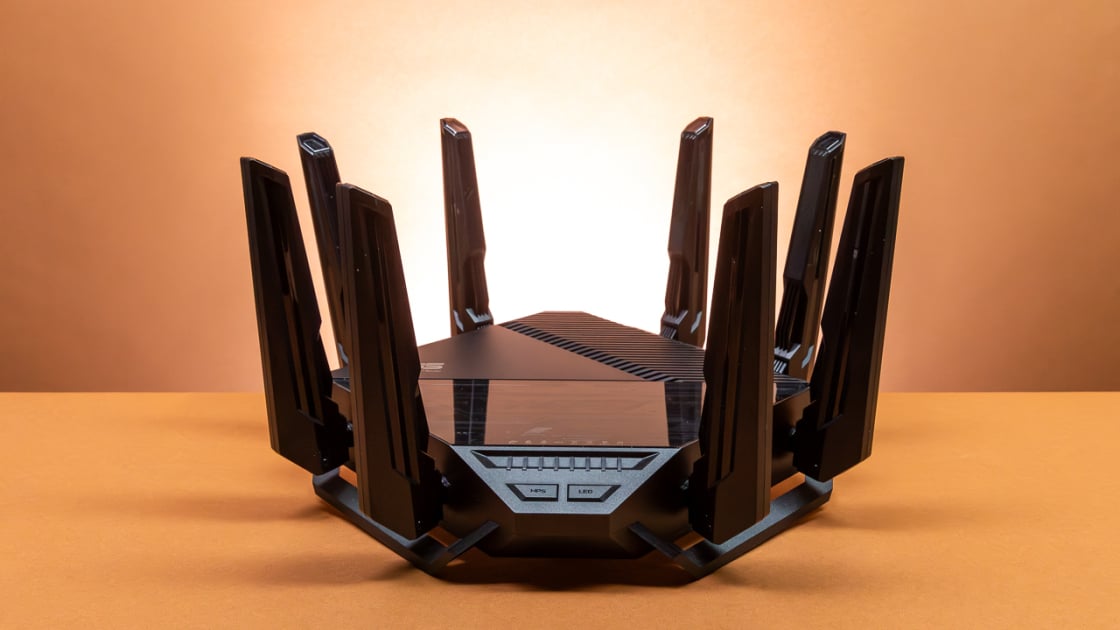
The Asus RT-BE96U ($699.99) is a massive tri-band Wi-Fi router that uses Wi-Fi 7 technology and a generous assortment of high-speed ports to deliver speedy throughput over the 2.4GHz, 5GHz, and 6GHz radio bands. As with most Wi-Fi 7 routers, it’s expensive, but you get many features for the money, including a pair of 10GbE networking ports, high-speed USB connectivity, free parental control software, and, most importantly, fast throughput performance. It’s an excellent choice if you’re ready to take the Wi-Fi 7 plunge, but you’ll get faster 6GHz performance and a few more multi-gig ports with its more expensive sibling and Editors’ Choice winner, the Asus ROG Rapture GT-BE98 Pro.Design: A Bulky Router Full of Cutting-Edge ComponentsThe RT-BE96U looks similar to the GT-BE98 Pro, in that they both use a hexagonal-shaped enclosure and have eight non-removable adjustable antennas. But the RT-BE96U lacks the gamer-centric backlit Republic of Gamers lighting effects of the GT-BE98 Pro. At 8.6 by 13.7 by 13.7 inches (HWD), this 4.1-pound router takes up a good deal of desktop real estate. As with the GT-BE98 Pro, the RT-BE96U uses a heatsink and specially designed vents to keep internal components cool.
(Credit: Joseph Maldonado)
Along the front edge are LED indicators for each radio band and for power, WAN, LAN, and WPS activity. The back panel is home to a 10GbE WAN/LAN port, a 1GbE WAN/LAN port, a 10GbE LAN port, and three 1GbE LAN ports, two of which support link aggregation. Here, you’ll also find a USB 3.2 Gen 1 port, a USB 2.0 port, a power switch, and a power jack.
(Credit: Joseph Maldonado)
Inside, the RT-BE96U has a quad-core CPU running at 2.6GHz, 2GB of RAM, and 256MB of flash memory. It’s a BE19000 router that can hit maximum (theoretical) data rates of up to 1,376Mbps on the 2.4GHz band, up to 5,764Mbps on the 5GHz band, and up to 11,529Mbps on the 6GHz band, for a total of approximately 19,000Mbps.
It supports the latest Wi-Fi 7 technologies, including 320MHz channel bandwidth, Orthogonal Frequency Division Multiple Access (OFDMA), Beamforming, Multi-Link Operation (MLO), 4096 QAM, WPA3 encryption, and MU-MIMO data streaming. As with the GT-BE98 Pro, it supports AiMesh technology, which allows you to use it as a node in a whole-home mesh network.You can install and manage the RT-BE96U using a web console or the Asus Router mobile app for iOS and Android devices, but you get more advanced settings with the web console. That said, the mobile app makes it easy to manage things using your phone. It opens to a Home screen with a panel at the top that shows the LAN IP and has a QoS icon that lets you prioritize bandwidth for gaming, streaming, web surfing, and file transfers. A circle in the center of the screen displays real-time traffic graphs, network band names, CPU and RAM usage, and the number of connected clients. You can scroll through each info screen by tapping the arrows.
(Credit: Asus)
Below the circle are the Internet Status, AiMesh, and Mobile Game Mode buttons. The Internet Status button takes you back to the above-mentioned screen, while the AiMesh button displays node information and allows you to add nodes to a mesh network. The Game Mode button takes you to a screen where you can optimize the network for mobile gaming and give mobile devices bandwidth priority.At the bottom of the screen is a Home button that returns you to the Home screen from wherever you are in the app, and a Devices button that opens a screen where you can see a list of each connected client. Tap any client name to view its IP and MAC addresses, limit its bandwidth, and assign it to a family profile. Use the Insight button to view security threats, share Wi-Fi settings, enable remote access, and search for mesh nodes. The Family button lets you create profiles and assign parental controls, including age-based web filters and scheduled access times.Lastly, the Settings button opens a screen where you can do things like configure a guest network, run diagnostics, block access to devices, enable local file sharing (Samba) for USB drives, and configure Wi-Fi, LAN, WAN, and VPN settings. Other settings let you update the firmware, connect with Alexa and Google voice assistants, run diagnostics, and check your internet upload and download speeds.Asus RT-BE96U Performance: The Wi-Fi 7 Speed You NeedLike most routers, the RT-BE96U is easy to set up and can be installed using the web console or the mobile app. I chose the latter. I connected the router to my modem, connected my desktop PC to the router’s 10GbE LAN port, and tapped Setup on the Welcome screen. I selected Asus Wi-Fi Routers and used my phone’s camera to scan the QR code on the bottom of the router. I tapped Get Started when the router was discovered, separated the bands, and gave the new network a name and password. I created a local login account and waited around 30 seconds for the app to apply my settings and set up my account. I connected to the new network and waited another 10 seconds for the router to optimize the network. Finally, I updated the firmware to complete the installation.The RT-BE96U is a solid performer. Its score of 150Mbps on the 2.4GHz close proximity test was a bit faster than the Asus GT-BE98 Pro (148Mbps) but not quite as fast as the TP-Link Archer BE800 (175Mbps). Similarly, its score of 83Mbps on the 30-foot test beat the GT-BE98 Pro (74Mbps) but not the Archer BE800 (88Mbps).
On the 5GHz close proximity test, the RT-BE96U’s score of 1,548Mbps trailed the Asus GT-BE98 Pro (1,828Mbps) and the TP-Link Archer BE800 (1,880Mbps). Also, its score of 906Mbps on the 30-foot test couldn’t match the GT-BE98 Pro (911Mbps) or the Archer BE800 (978Mbps).While operating on the 6GHz band, the RT-BE96U garnered 2,451Mbps on the close proximity test and 311Mbps on the 30-foot test. That’s faster than the Archer BE800 (2,280Mbps and 232Mbps, respectively) but not the GT-BE98 Pro, which scored a blistering 3,075Mbps on the close proximity test and a speedy 442Mbps on the 30-foot test.To test file transfer performance, we measure read and write speeds by moving a 1.5GB folder containing photos, video, music, and office document files back and forth between a USB 3.0 drive and our desktop PC, both of which are connected to the router. The RT-BE96U scored 82MBps on the write test and 83MBps on the read test. The GT-BE98 Pro scored 89MBps on both tests, while the Archer BE800 scored 102MBps on the write test and 109MBps on the read test.
The RT-BE96U did a good job on our signal strength tests, in which we use an Ekahau Sidekick 2 diagnostic device and Ekahau’s Survey software to generate heat maps that show the signal reach for each radio band. (Note: Ekahau is owned by Ziff Davis, PCMag.com’s parent company. For more, read about our ethics policy in the Editorial Mission Statement.) On the maps, the circle represents the router’s location, and the colors represent signal strength. Dark green areas indicate the strongest signal and lighter yellow areas indicate a weaker one. Gray areas indicate very weak or no measurable signal reception.
A 2.4GHz Wi-Fi coverage map for the Asus RT-BE96U Wi-Fi 7 Router (Credit: Ekahau)
A 5GHz Wi-Fi coverage map for the Asus RT-BE96U Wi-Fi 7 Router (Credit: Ekahau)
A 6GHz Wi-Fi coverage map for the Asus RT-BE96U Wi-Fi 7 Router (Credit: Ekahau)
The first two maps show that the router had no trouble broadcasting strong 2.4GHz and 5GHz signals throughout our test home, but 6GHz signals showed weak range. We also saw this with the Archer BE800 and GT-BE98 Pro. For the time being, it is a known limitation of 6GHz transmissions. They offer astonishing same-room performance, but they peter out faster than transmissions on the other bands the further away from the router you move. Verdict: Big, Fast, and ExpensiveYou’ll have to clear some space on your desktop to make room for the Asus RT-BE96U, but once you do, you’ll be rewarded with speedy 6GHz transmissions, excellent signal coverage, and high-speed wired connectivity via a pair of 10GbE networking ports. It’s easy to set up and manage, comes with free network security and parental control software, and offers a handful of gamer-friendly settings. Still, if you’re in the market for a Wi-Fi 7 router right now, money is probably no object, so you should consider spending another $100 for the Asus ROG GT-BE98 Pro. It’s one of the fastest routers we’ve tested, offering more multi-gig ports and gamer-centric features than the RT-BE96U.
Cons
Expensive
Physically large
The Bottom Line
The Asus RT-BE96U has a big footprint and a hefty price tag, but it delivered speedy throughput and strong signal performance in testing, making it an excellent tri-band Wi-Fi 7 router.
Like What You’re Reading?
Sign up for Lab Report to get the latest reviews and top product advice delivered right to your inbox.
This newsletter may contain advertising, deals, or affiliate links. Subscribing to a newsletter indicates your consent to our Terms of Use and Privacy Policy. You may unsubscribe from the newsletters at any time.






